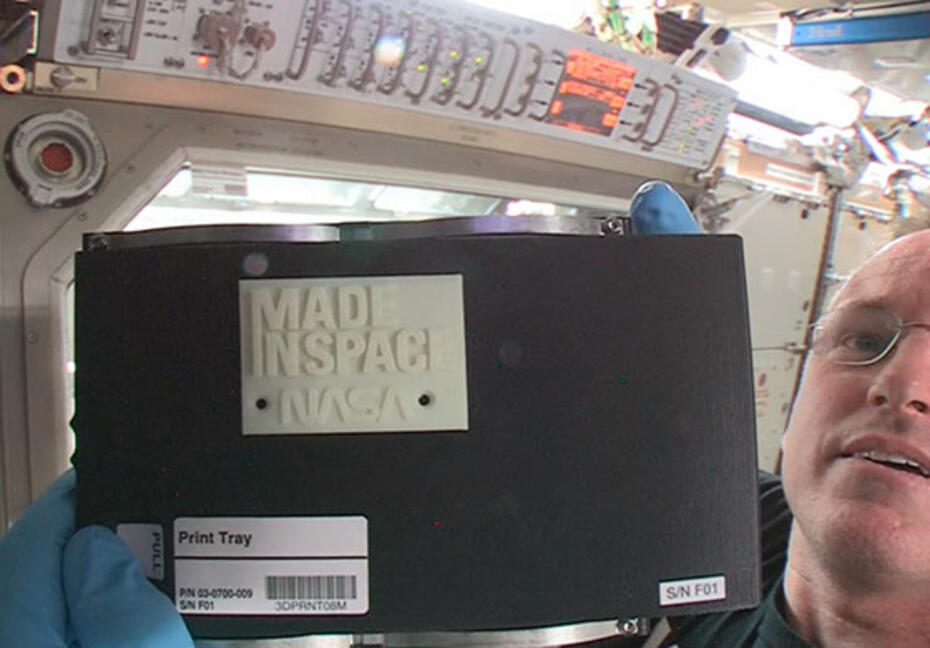3D-Drucker erzeugt erstes Objekt im All
Der 3D-Drucker in der internationalen Raumstation ISS hat das erste Objekt im Weltall 3D-gedruckt und ebnet damit den Weg zu längeren Raumfahrtexpeditionen in der Zukunft / The International Space Station’s 3-D printer has manufactured the first 3-D printed object in space, paving the way to future long-term space expeditions

------------------------ scroll down for English version -------------------------------
NASA-Astronaut Barry Wilmore, Kommandant der Expedition 42 an Bord der ISS, nahm den Drucker am 17. November in Betrieb und führte den ersten Testdruck zu Kalibrierzwecken durch. Anhand der Ergebnisse des Testdrucks sendete das Bodenkontrollteam die Kommandos zur Neueinstellung des Druckers und führte am 20. November einen zweiten Kalibriertest durch. Diese Tests bestätigten, dass der Drucker für Fertigungsprozesse einsatzbereit ist. Am 24. November sendete das Bodenkontrollteam den Befehl an den Drucker, das erste gedruckte Teil herzustellen: eine kleine Platte für das Extrudergehäuse. Dies zeigte, dass der Drucker Ersatzteile für sich selbst erzeugen kann.
Die Demonstration von 3D-Druck in Zero-G-Technologie an Bord der ISS soll deutlich machen, dass durch additive Fertigung eine Vielzahl von gedruckten 3D-Teilen und Werkzeugen im All hergestellt werden kann. Das erste im All in 3D gedruckte Objekt, die Platte für den Druckkopf, zeigt in erhabener Schrift die Namen der Organisationen, die an dieser Technologievorführung in der Raumstation beteiligt waren: NASA und Made In Space, das Weltraum-Produktionsunternehmen, das zusammen mit der NASA den 3D-Drucker entwickelt, gebaut und getestet hat.
“We chose this part to print first because, after all, if we are going to have 3-D printers make spare and replacement parts for critical items in space, we have to be able to make spare parts for the printers,” sagte Werkheiser. “If a printer is critical for explorers, it must be capable of replicating its own parts, so that it can keep working during longer journeys to places like Mars or an asteroid. Ultimately, one day, a printer may even be able to print another printer.”
Ingenieure von Made In Space wiesen den Drucker in Zusammenarbeit mit dem Kontrollteam am Payload Operations Integration Center der NASA in Huntsville an, dieses erste Objekt zu erzeugen. Während die ersten Objekte gedruckt werden, überwachen Ingenieure von NASA und Made In Space die Herstellung über zur Erde gesendete Bilder und Videos. Der größte Teil des Druckprozesses wird vom Boden aus überwacht, um die benötigte Arbeitszeit der Crew auf ein Minimum zu beschränken.
Die ersten im All erstellten Objekte sollen 2015 zur Erde gebracht werden, um detaillierte Analysen und Vergleiche mit identischen Exemplaren durchzuführen, die von der Bodenkontrolle bereits vor dem Start und nach den abschließenden Flugtests am Marshall Center der NASA mit diesem Drucker gefertigt wurden. Ziel dieser Analyse ist es, nachzuweisen, dass 3D-Druck in der Mikrogravitation genauso funktioniert wie auf der Erde.
Hier finden Sie ein Video des ersten 3D-Drucks im All.
_______________________________________________________________
3D Printer Creates First Object in Space on International Space Station
NASA astronaut Barry "Butch" Wilmore, Expedition 42 commander aboard the International Space Station, installed the printer on Nov. 17 and conducted the first calibration test print. Based on the test print results, the ground control team sent commands to realign the printer and printed a second calibration test on Nov. 20. These tests verified that the printer was ready for manufacturing operations. On Nov. 24, ground controllers sent the printer the command to make the first printed part: a faceplate of the extruder’s casing. This demonstrated that the printer can make replacement parts for itself.
The 3-D Printing in Zero-G Technology Demonstration on the space station aims to show additive manufacturing can make a variety of 3-D printed parts and tools in space. The first object 3-D printed in space, the printhead faceplate, is engraved with names of the organizations that collaborated on this space station technology demonstration: NASA and Made In Space, Inc., the space manufacturing company that worked with NASA to design, build and test the 3-D printer.
Made In Space engineers commanded the printer to make the first object while working with controllers at NASA’s Payload Operations Integration Center in Huntsville. As the first objects are printed, NASA and Made In Space engineers are monitoring the manufacturing via downlinked images and videos. The majority of the printing process is controlled from the ground to limit crew time required for operations.
The first objects built in space will be returned to Earth in 2015 for detailed analysis and comparison to identical ground control samples made on the flight printer after final flight testing earlier this year at, NASA’s Marshall Center prior to launch. The goal of this analysis is to verify that the 3-D printing process works the same in microgravity as it does on Earth.
Wach the video of the first printed part in space.





